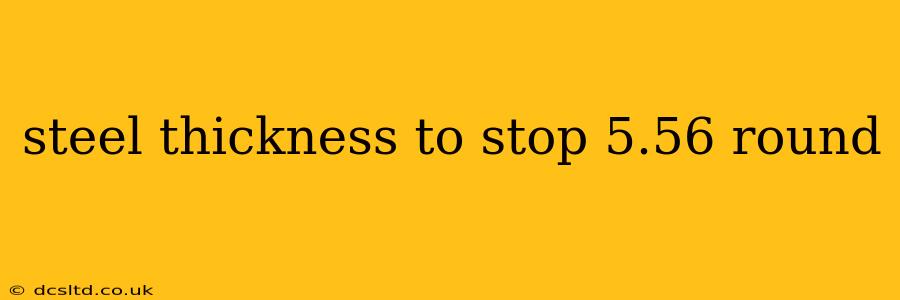The question of how much steel is needed to stop a 5.56x45mm NATO round is complex, depending on several crucial factors. There isn't a single definitive answer, as the required thickness varies significantly based on the projectile's velocity, the steel's type and hardness, the angle of impact, and even the specific ammunition used. This guide will explore these variables and provide a clearer understanding of the necessary steel thickness for effective protection.
What Factors Influence Steel Thickness Requirements?
Several factors contribute to the effectiveness of steel armor against 5.56 rounds:
-
Steel Type and Hardness: Different types of steel possess varying degrees of hardness and tensile strength. Higher hardness steels, such as hardened armor steel, will naturally require less thickness to stop a round compared to softer, less durable steels. The specific alloy composition significantly influences performance.
-
Projectile Velocity: A faster-moving bullet possesses more kinetic energy upon impact, requiring thicker steel for penetration resistance. Factors like barrel length and ammunition type influence the muzzle velocity.
-
Angle of Impact: A round striking at a perpendicular angle will transfer more energy to the steel plate than one striking at an oblique angle. A glancing blow may ricochet or penetrate with less force.
-
Ammunition Type: Different 5.56mm rounds have varying designs, weights, and construction. Some rounds are designed for armor penetration, and will necessitate thicker steel plating for protection than others.
-
Steel Plate Construction: The manufacturing process and overall quality of the steel plate impact its ability to withstand the impact. Imperfections or flaws in the material can compromise its protective capabilities.
How Thick Does Steel Need to Be?
There's no single magic number. However, various sources suggest that hardened steel plates ranging from 6mm to 12mm thickness can offer varying degrees of protection against standard 5.56mm rounds. However, this is a broad estimate, and the actual effectiveness greatly depends on the factors mentioned above. A thicker plate will always provide better protection. Remember, even with sufficient steel thickness, spalling (fragmentation of the steel plate on impact) can still occur, creating secondary projectiles and posing a risk.
What about AR500 steel?
AR500 steel is a popular choice for shooting targets, and while it offers decent hardness, its suitability for personal protection against 5.56 rounds is debated. While it can stop some rounds, it is not designed or guaranteed for consistent protection against all 5.56mm rounds under various conditions. It’s crucial to remember that using AR500 steel for personal protection against ballistic threats should be approached with extreme caution.
Is Steel the Best Material for Stopping 5.56 Rounds?
While steel offers cost-effectiveness in certain applications, it's not necessarily the best material for stopping 5.56 rounds. Other materials, like ceramic composite armor or advanced polymer matrix composites, offer superior protection at potentially lower weights. However, these materials are typically more expensive and require more sophisticated manufacturing processes.
What are the risks of using insufficiently thick steel?
Using steel that is too thin to stop a 5.56 round exposes the user to significant risk of serious injury or death. The round could penetrate the steel, causing trauma to underlying tissues and organs. Even if the round doesn’t completely penetrate, the impact force could cause fractures or internal injuries.
Disclaimer:
This information is for educational purposes only and should not be considered professional advice. The selection and use of ballistic protection materials require expert consultation to ensure appropriate protection for specific threats and situations. Improperly selected or used armor can be dangerous. Always consult with qualified professionals before making decisions regarding personal safety and ballistic protection.
